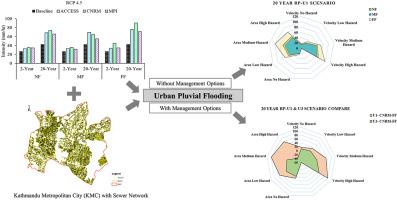Journal of Environmental Management ( IF 8.7 ) Pub Date : 2021-01-04 , DOI: 10.1016/j.jenvman.2020.111894 Saurav KC , Sangam Shrestha , Sarawut Ninsawat , Somchai Chonwattana

|
Urbanisation and climate change collectively impose the threat of urban flood. The impervious transformation and changes in local climatic conditions increase the risk of frequent pluvial flooding in Kathmandu. Therefore, this study aims to assess the integrated impact of urbanisation and climate change on pluvial flooding in Kathmandu Metropolitan City, using the Personal Computer Storm Water Management Model. The future daily rainfall from three Regional Climate Models under two Representative Concentration Pathways (RCPs) and the observed daily data has been disaggregated to hourly series using temporal rainfall disaggregation. The result shows that the combined impact on pluvial flood is likely to intensify with relatively more contribution from climate change. The CNRM-CM5-CSIRO-CCAM under the RCP 4.5 scenario projects the maximum increase (60–90%) in flood volume for current (75%) and extreme (90%) imperviousness, under a 2-year and 20-year return period (RP) with the extent of the flood area increasing more than the depth. For a 2-year RP, areas with a depth of 0.10–0.25 m are likely to expand while those from 0.25 to 0.40 m in depth are projected to have more velocity, and these trends are expected to be magnified for higher RPs. The study shows that even though urbanisation contributes less to urban pluvial flood, it can be a catalyst for exaggerating other factors and implementing management measures. For instance, the application of small-scale rainwater harvesting, and overflow storage reduced the runoff, thereby reducing the flood volume by 20–35%. Furthermore, the findings highlight the need for planning management strategies such as evaluation and upgrading of conventional drainage systems with low impact measures (rainwater harvesting and green roofs); technical and financial assistance to urban dwellers in adopting the management measures or a combination of them based on the location, requirements, and availability of information and resources to reduce the effects of pluvial flood in Kathmandu.
中文翻译:

预测气候变化和城市化下加德满都都会的洪水事件
城市化和气候变化共同构成了城市洪灾的威胁。不可渗透的变化和当地气候条件的变化增加了加德满都频繁进行洪水泛滥的风险。因此,本研究旨在使用个人计算机雨水管理模型来评估城市化和气候变化对加德满都都会的小洪水的综合影响。根据两个代表性的集中路径(RCP),使用三种区域气候模型得出的未来日降水量和观测到的每日数据已使用时间降水量分解为小时序列。结果表明,随着气候变化的贡献更大,对小洪水的综合影响可能会加剧。RCP下的CNRM-CM5-CSIRO-CCAM 4。5个方案预测了在2年和20年的恢复期(RP)下,随着洪水面积的增加,当前(75%)和极端(90%)防渗能力的洪水量最大增加(60–90%)比深度增加更多。对于一个为期2年的RP,深度为0.10–0.25 m的区域可能会扩展,而深度从0.25到0.40 m的区域预计会具有更大的速度,并且对于更高的RP,这些趋势预计会被放大。研究表明,尽管城市化对城市洪灾的贡献较小,但它可能是夸大其他因素和实施管理措施的催化剂。例如,小规模雨水收集和溢流存储的应用减少了径流,从而使洪水量减少了20-35%。此外,调查结果突出表明,需要制定计划管理战略,例如评估和升级低影响措施(雨水收集和屋顶绿化)的常规排水系统;向城市居民提供技术和财政援助,以根据其位置,要求以及信息和资源的可用性,采取管理措施或将其综合起来,以减少加德满都的洪水泛滥的影响。

























 京公网安备 11010802027423号
京公网安备 11010802027423号